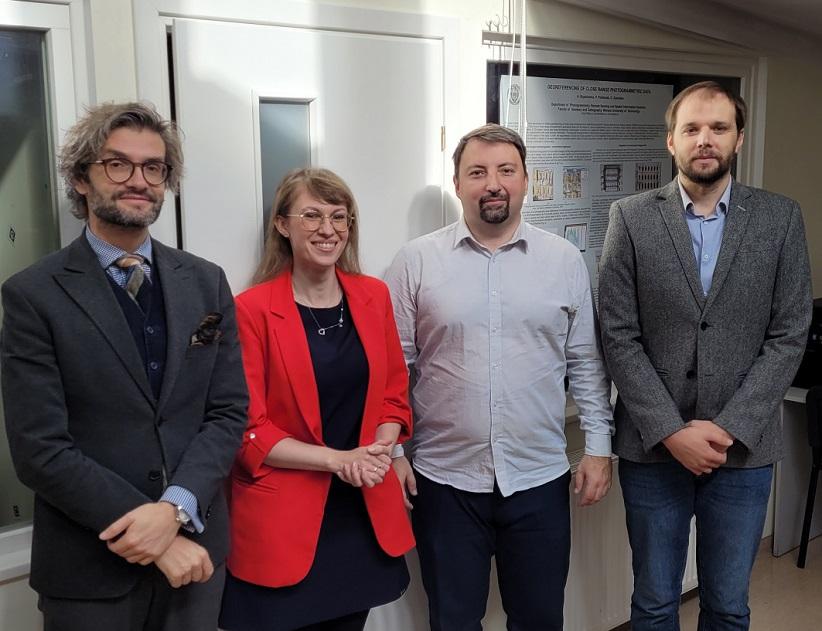This project will facilitate the creation of a high-resolution land cover map for the entire world
Experts from three WUT faculties are developing an automatic method of global land cover/land use classification for forests and development. Researchers are to conduct tests in five areas located in various parts of the globe to demonstrate the possibilities of the devised solution. Their project is implemented under the BEYOND POB II grant.

From the left: Przemysław Kupidura, PhD, DSc, Associate Professor; Anna Płatek-Żak, MSc; Artur Nowakowski, DSc; Oskar Graszka, MSc.
Detailed classifications of forests and development are widely used in urban planning, landscape architecture, environmental protection, and crisis situations, among other things. Such data are indispensable for budgetary units to estimate the currently owned resources, to mark safe emergency routes and access paths for services during natural disasters, to forecast fire spread, to protect selected plant and animal species, etc.
“Precise and up-to-date spatial data are a basis in the decision-taking process,” explains Artur Nowakowski, DSc, from the Faculty of Geodesy and Cartography at WUT. “There already exists research similar to our project but it is conducted on a local scale of states or regions. Research conducted on a global scale is scarce,” he adds.
In their project, WUT researchers have focused on the division of forests into coniferous and deciduous, and the division of development into subclasses (buildings and road infrastructure). Their work is possible thanks to satellite imagery from the Sentinel-2 mission, which consistently provides high-resolution Earth images. The imagery served as the basis for the map of land cover for Europe with 10-metre spatial resolution. Dr Nowakowski was the co-originator and co-implementor of the project. Currently, he wants to translate that experience into a project implemented at WUT.
“In the case of forests, we would like to create a global-scale classification model, which could indicate where a specific type of forest is located. In the case of development, we aim to observe the occurring changes, e.g. where new roads are underway or how fast new buildings are constructed. There are no maps like that on a global scale,” says Artur Nowakowski, DSc.
The selection of testing areas
Researchers are in the initial stages of work which involve collecting the data. It is extremely time-consuming.
“We have focused on five testing areas,” says Anna Płatek-Żak, MSc, from the Faculty of Geodesy and Cartography of WUT. “It is important to us that these areas include diverse forest stands and diverse development. The testing areas are in Europe, North and South America, Africa and Asia. They include various climate zones and culture circles,” she explains.
Process automation
The developed classification methods will be implemented by machine learning algorithms, both convoluted deep networks and classical methods. To make this happen, it is necessary to prepare a tagged database.
“Initial data must be controlled at the level of photointerpretation,” says Przemysław Kupidura, PhD, DSc, Associate Professor at the Faculty of Geodesy and Cartography at WUT. “This can be done by humans, but to save the time and make the work more efficient, we want to automate the process,” he explains.
Researchers are using available database which includes information from a few previous years or data collected by the users. Although it does not offer one hundred per cent certainty, it is sufficient to train the model.
“A good neural network can generalise, so even if errors significant at a local level occur, such data are rejected at a global level as insignificant,” says Professor Kupidura.
In their work, researchers are using distributed computing in the WUT’s CENAGIS network.
“The whole automation would not be possible if it was not for the WUT’s CENAGIS network, use of programmer’s scripts and programmer’s interface of spatial data providers, which we are utilising as well,” explains Oskar Graszka, MSc.
Plans for future
This is a pilot project. Researchers focus on five selected areas to test the model in various parts of the world. They are planning to apply for another grant which would allow them to compute such maps for the entire world.
-
The project” Development of automatic global land use/land cover classification methods for selected thematic classes” is funded within the BEYOND POB II research grant under the programme Excellence Initiative – Research University implemented at the Warsaw University of Technology.
Research team:
Artur Nowakowski, DSc; Przemysław Kupidura, PhD, DSc, Associate Professor; Anna Płatek-Żak, MSc; Oskar Graszka, MSc; Karol Przeździecki, DSc; Professor Jarosław Zawadzki, PhD, DSc; Professor Władysław Skarbek, PhD, DSc; Dr Dario Spiller (Sapienza University of Rome).

